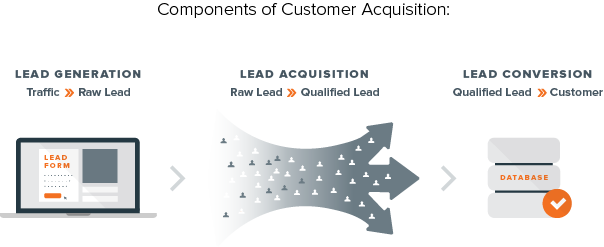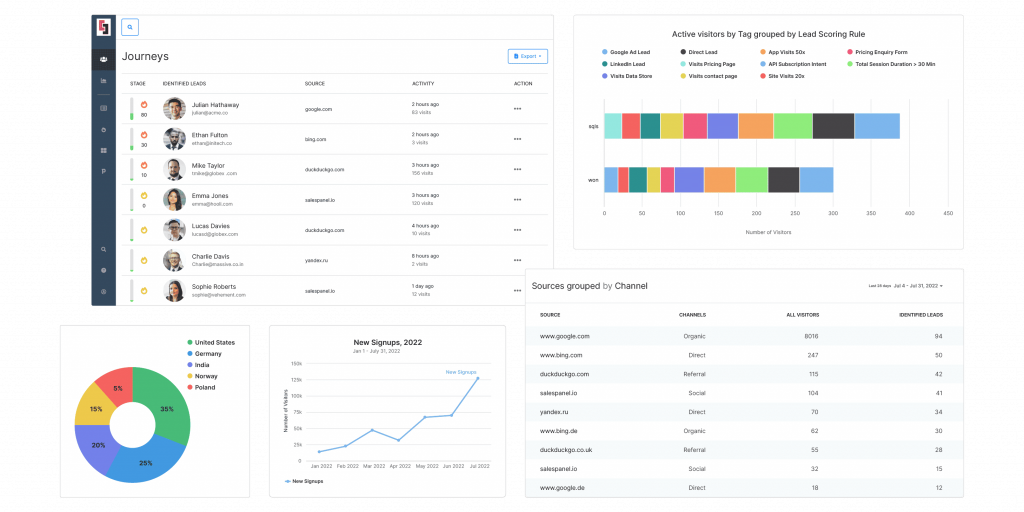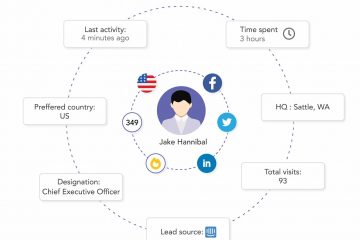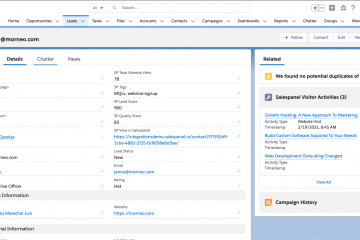What is Lead Acquisition? Best Strategies For 2023
All businesses need to sell to make money. To sell, they need people or businesses to sell to i.e ‘leads’. Therefore, generating leads is critical for customer acquisition and making revenue.
Lead generation is the process of attracting potential customers to your business and engaging them with the ultimate objective of converting them into customers.
Now, you might be wondering, when we say “generation”, do we also mean “acquisition”? Is lead generation the same as lead acquisition? If not, how is lead acquisition different and how can good acquisition strategies be implemented?
We will discuss all of these in this article. Let’s begin!
What is Lead Acquisition?
A lead is a person or a business with an interest in buying the products or services you sell. Lead acquisition is the process of you obtaining a new lead and qualifying and nurturing them as you work towards converting them.

Image Source: ActiveProspect
How is Lead Acquisition Different from Lead Generation?
If we go by linguistics alone, lead generation should be pretty similar to lead acquisition. Although, since the latter focuses on acquiring, one could say that the acquisition happens when the lead enters the funnel by filling out a form or scheduling a meeting. However, this is not what everyone agrees with.
While many use lead generation and lead acquisition interchangeably, some parties have defined lead acquisition as the next step after lead generation. This is when you nurture, segment, and qualify your leads and send them to the next stages of the funnel. So, everything between lead generation and conversion would come under ‘lead acquisition’ territory.
There is another definition that we see floating around. Some websites claim that while ‘lead generation is the generation of leads by you, ‘lead acquisition is the process of acquiring qualified leads from a third-party vendor. This definition, however, feels dubious and might have been pushed by vendors who sell leads.
Since there is no fixed definition laid by a foundation with authority, we thought it would be best to present to you all the definitions circulating in the space. Pick as you prefer!
Best Lead Acquisition Strategies to Improve Your ROI
Now that we more or less understand what lead acquisition means, let’s talk about strategies that can help you generate better quality leads, improve your funnel, and acquire more customers.
Quality over quantity
Lead generation is not hard. What is hard is the acquisition of leads who will actually buy from you.
Acquire leads from marketing channels that bring good results. Or, if you are sourcing outbound leads, make sure you source high-quality leads.
Check for intent
Let’s say you are a lead scoring software company. Lead A searches for “lead scoring” and Lead B searches for “best lead scoring software”. Which of these two leads do you think has more intent? While Lead A might just be looking for information on lead scoring, Lead B is looking at tools.
Acquisition of leads with clear intent is more likely to have better conversion rates for your business.
Monitor entire customer journeys and use attribution
The lead acquisition process runs through the entire journey of your customer. As such, building an efficient funnel needs you to monitor customer journeys.
Customer journey tracking helps you understand how leads engage with your sales and marketing content before they purchase. It lets you identify channels that bring high-quality leads, attribute marketing engagement and channels with conversions, and optimize the experience for more efficient acquisition.
A tool like Salespanel can help you do this.
Qualify your leads
While ‘lead generation’ focuses on the raw number of leads, ‘lead acquisition’ measures the acquisition of qualified leads. As such, for this system, it is important to have a lead qualification framework.
Not every lead you generate will be qualified. Spending resources on them would be a waste. A lead qualification framework using lead scoring and/or segmentation is used to find your best leads.
Lead qualification is heavily dependent on data which is why you need to collect and analyze a lead’s profile and behavioral data. If your customers are B2B, you can prioritize leads who match your target customer profile and are decision-makers. We have already discussed behavioral attributes that imply intent in the previous section.
Use segmentation
Not all of your leads have the same customer profiles and are looking for the same solutions. As such, it is important to segment your leads and sort your buyer profiles. This way you can use the segments to qualify, prioritize, and show targeted content.
Leads can be segmented based on:
- Buyer profile and firmographic characteristics
- Acquisition channels (through attribution)
- Key behavioral traits
- And, many other attributes.
Do proactive marketing during the acquisition process
All of these data points and marketing power mean that you no longer need to be reactive during the acquisition process. Instead, you can proactively engage your leads with highly targeted and personalized content and fast-track leads who are more likely to buy.
Segment and qualify leads in real-time and show content that will resonate with them.
Automate and Track Your Lead Acquisition Process
We have talked about lead acquisition and several strategies that can help you in the process. But, the question is how do you execute them?
Every great strategy needs a great tool (or tools). We will start with a customer journey tracking implementation as this sets the foundation for your lead acquisition framework.
Salespanel can help you track the entire journey of every visitor on your website right from their first visit to their last. It will track the source of your visitor and attribute it to your marketing campaign. The usage of UTM parameters (and ValueTrack template for Google ads) can help you with more accurate attribution.
Once journey tracking is set up, the behavioral data is available for you to implement several functions. You can use behavioral data to:
- Send targeted email campaigns based on intent
- Gradually score leads
- Segment high-intent profiles
- Show personalized content based on interests.
All of these can be implemented with the help of Salespanel. The tool also provides you firmographic data but if you need more vivid data, a data platform like Clearbit or ZoomInfo can help.

Closing Thoughts
While the definition of lead acquisition is murky, it doesn’t change what you need to do to improve your lead generation and customer acquisition process. Once a lead is acquired you have to do the needful to nurture and qualify, and send qualified leads to your sales reps. This makes you more resourceful while helping you acquire better customers. You can double down on high-performing campaigns and strengthen your overall lead acquisition strategy.
Sell more, understand your customers’ journey for free!
Sales and Marketing teams spend millions of dollars to bring visitors to your website. But do you track your customer’s journey? Do you know who buys and why?
Around 8% of your website traffic will sign up on your lead forms. What happens to the other 92% of your traffic? Can you identify your visiting accounts? Can you engage and retarget your qualified visitors even if they are not identified?



